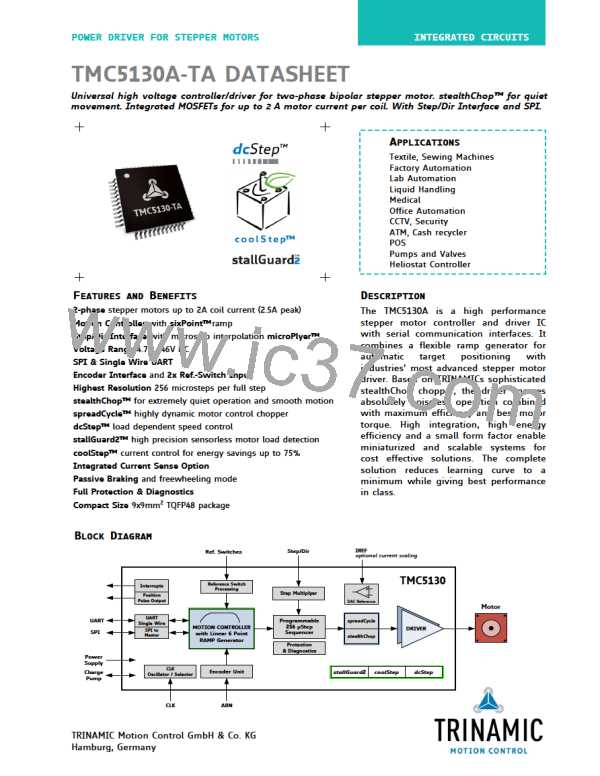TMC5130A DATASHEET (Rev. 1.14 / 2017-MAY-15)
56
ꢘ
ꢚ
푉
퐻표푙푑푖푛푔ꢖ표푟푞푢ꢗ ꢙꢍ
퐶퐵ꢓ푀퐹
ꢔ
ꢕ =
푟푎푑/푠
ꢀ ∗ 퐼ꢋ푂ꢌ퐿푁푂푀ꢘꢎꢚ
ICOILNOM is the motor’s rated phase current for the specified holding torque
HoldingTorque is the motor specific holding torque, i.e. the torque reached at ICOILNOM on both coils.
The torque unit is [Nm] where 1Nm = 100Ncm = 1000mNm.
The voltage is valid as RMS voltage per coil, thus the nominal current is multiplied by 2 in this
formula, since the nominal current assumes a full step position, with two coils operating.
7.4 Combining stealthChop and spreadCycle
For applications requiring high velocity motion, spreadCycle may bring more stable operation in the
upper velocity range. To combine no-noise operation with highest dynamic performance, combine
stealthChop and spreadCycle based on a velocity threshold (TPWMTHRS). With this, stealthChop is only
active at low velocities.
As a first step, both chopper principles should be parameterized and optimized individually. In a next
step, a transfer velocity has to be fixed. For example, stealthChop operation is used for precise low
speed positioning, while spreadCycle shall be used for highly dynamic motion. TPWMTHRS determines
the transition velocity. Use a low transfer velocity to avoid a jerk at the switching point.
A jerk occurs when switching at higher velocities, because the back-EMF of the motor (which rises
with the velocity) causes a phase shift of up to 90° between motor voltage and motor current. So
when switching at higher velocities between voltage PWM and current PWM mode, this jerk will occur
with increased intensity. A high jerk may even produce a temporary overcurrent condition (depending
on the motor coil resistance). At low velocities (e.g. 1 to a few 10 RPM), it can be completely
neglected for most motors. Therefore, consider the switching jerk when choosing TPWMTHRS. Set
TPWMTHRS zero if you want to work with stealthChop only.
When enabling the stealthChop mode the first time using automatic current regulation, the motor
must be at stand still in order to allow a proper current regulation. When the drive switches to a
different chopper mode at a higher velocity, stealthChop logic stores the last current regulation
setting until the motor returns to a lower velocity again. This way, the regulation has a known
starting point when returning to a lower velocity, where stealthChop becomes re-enabled. Therefore,
neither the velocity threshold nor the supply voltage must be considerably changed during the phase
while the chopper is switched to a different mode, because otherwise the motor might lose steps or
the instantaneous current might be too high or too low.
A motor stall or a sudden change in the motor velocity may lead to the driver detecting a short
circuit or to a state of automatic current regulation, from which it cannot recover. Clear the error flags
and restart the motor from zero velocity to recover from this situation.
Hint
Start the motor from standstill when switching on stealthChop the first time and keep it stopped for
at least 128 chopper periods to allow stealthChop to do initial standstill current control.
7.4.1 PWM_AMPL limits Jerk
When combining stealthChop with spreadCycle or constant off time classic PWM, a switching velocity
can be chosen using TPWMTHRS. With this, stealthChop is only active at low velocities. Often, a very
low velocity in the range of 1 to a few 10 RPM fits best. In case a high switching velocity is chosen,
special care should be taken for switching back to stealthChop during deceleration, because the phase
jerk can produce a short time overcurrent.
To avoid a short time overcurrent and to minimize the jerk, the initial amplitude for switching back to
stealthChop at sinking velocity can be determined using the setting PWM_AMPL. Tune PWM_AMPL to a
value which gives a smooth and safe transition back to stealthChop within the application. As a
thumb rule, ½ to ¾ of the last PWM_SCALE value which was valid after the switching event at rising
velocity can be used. For high resistive steppers as well as for low transfer velocities (as set by
TPWMTHRS), set PWM_AMPL to 255 as most universal setting.
www.trinamic.com

 TRINAMIC [ TRINAMIC MOTION CONTROL GMBH & CO. KG. ]
TRINAMIC [ TRINAMIC MOTION CONTROL GMBH & CO. KG. ]